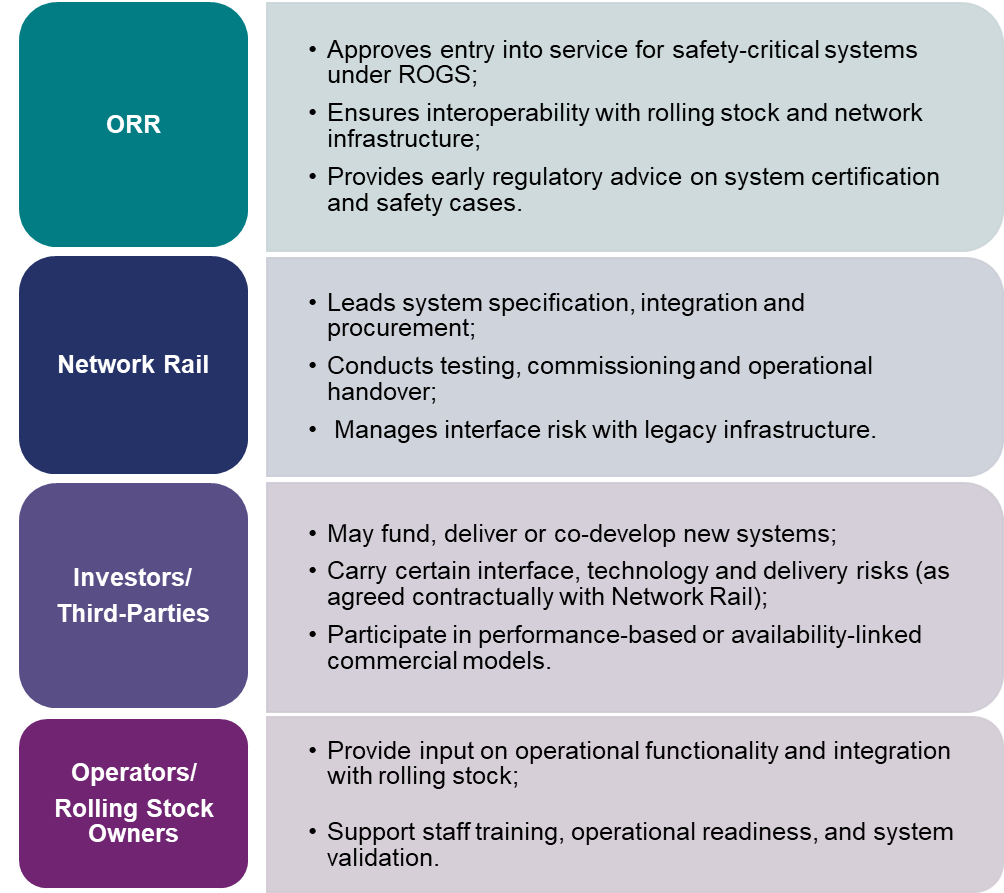Why it’s an opportunity
5.1 Modern signalling and train control systems are critical to the delivery of a higher-capacity, safer and more resilient railway. With much of the UK network still reliant on legacy infrastructure, investment in digital signalling offers various potential opportunities:
- Digital Railway Implementation
- Investment aligns with national and industry policy priorities;
- Helps unlock long-term network capacity and reliability improvements.
- Asset Modernisation and Resilience
- Replacing life-expired signalling reduces maintenance costs and disruption;
- Increase line capacity and reduce headways;
- Improve operational resilience and service recovery;
- Enhances safety through automation and reduced potential for human error.
- Innovation and Private Sector Delivery Models
- Long-term partnerships or joint ventures can deliver significant outcomes.
5.2 For investors, these systems offer scope to develop, deliver or finance upgrades in partnership with Network Rail or operators.
Key Stakeholders – Roles and responsibilities
5.3 Below are examples of some of the common responsibilities of key stakeholders, although this may vary depending on the scope of the investment scheme:

Key considerations for investors
| Theme | Detail |
|---|---|
| Interoperability | New systems must work with existing trains and infrastructure; overlay running may be required. |
| Safety & Assurance | Projects require robust documentation, staged testing, and ORR engagement at each gateway. |
| Commercial Structures | May involve availability payments, lifecycle cost models or outcome-based incentives. |
| Delivery Risk | Interface complexity and phased commissioning introduce risk to cost and schedule. |
Regulatory and contractual considerations
5.4 Below is an example of how investment in signalling infrastructure can be facilitated, along with some of the common regulatory requirements in this area:
5.5 Early engagement
Early engagement with NR and ORR is essential to establish technical feasibility, integration requirements and the applicable regulatory approval pathway.
5.6 Development and feasibility
A Development Services Agreement (DSA) is typically used to assess system feasibility, interface design, capacity implications, and regulatory compliance. This stage helps define assurance requirements and confirm how the new or modified signalling system will integrate with existing control, communications and safety systems.
5.7 Delivery arrangements
Delivery generally proceeds under an Asset Protection Agreement (APA) or bespoke contract, depending on the project’s scale and complexity. High-value or complex schemes (usually over £50 million) often adopt bespoke contractual terms with defined phased assurance milestones for design, testing, commissioning and entry into service.
5.8 Technical and operational integration
Close collaboration with Network Rail is required to scope system interfaces, testing regimes, commissioning plans and future asset ownership arrangements. Engagement with train operators and rolling stock owners should begin early to ensure compatibility and minimise operational disruption.
Checklist for signalling investors
5.9 Investors should consider the following when developing a signalling investment project:
- Has the system’s operational impact been defined and modelled?
- Have rolling stock requirements for digital signalling been identified?
- Are ORR and NR safety assurance processes clearly understood?
- Are technical and commercial interfaces with existing infrastructure mapped?

